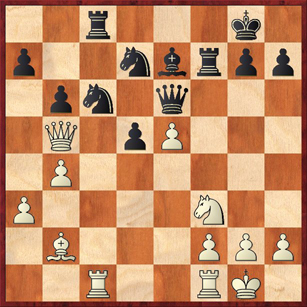At the Aptos libary chess club yesterday I showed the children this position, from one of my ChessLectures (Learn from Your Fellow Amateurs, Episode VIII: Red Flags).
I think that this is a great position to look at with a group of beginners, because it has so many of the tactical features that they need to learn about. It has loose pieces, forks, pins, in-between moves and discovered attacks — what more could you ask for? This is a good illustration of why you can sometimes learn more from games between lower-rated players than from master games. Here, both players were about 1300 strength. Black is a piece up, but he just played the terrible move 23. … Rf8-f7??, overlooking several red flags: the pin on the c-file, the undefended rook on c8, and the exposed queen on e6. A master would never consider playing such a move. But now we can see lots of great tactics in action.
The first question I asked was what are the weak points in Black’s position. Somewhat to my surprise, the kids did not mention the rook on c8 or the queen on e6, but they all focused on the knight at c6. I guess that is easy to see because that is what White’s pieces are attacking. And it’s true: the pressure on c6 is a crucial ingredient in the position. So I went with that, and asked them how they could increase the pressure on that knight. Very soon the idea of 24. Nd4 was suggested. But then one of the kids pointed out that after 24. Nd4 Black could just defend the knight with 24. … Ndb8. I said “Very good. But what else was the move 24. Nd4 threatening?” Oh, yeah! … The queen! And what do we call it when we attack two pieces at once? A fork!
So is there anything Black can do about this fork? After a while, a hand went up: You can take the knight on d4! After 24. … Nxd4 25. Bxd4, it’s just an even trade, and Black is doing well because he’s a piece up.
But wait a minute … When your opponent takes your piece, you don’t always have to take back the same piece. Is there something else that we can capture? Maybe an even bigger piece? Aha! Another kid comes up to the demo board (forget about raising your hand, this is too exciting) and plays 25. Rxc8 check!
What a great move! I asked them what it’s called when you have a piece that can’t move because a bigger piece behind it would be captured. That question stumped them, and so I reminded them about pins. (Memo: Pins are harder for kids to see than forks.) Although I didn’t tell them this, I think that the pin is actually the first feature of the position that a stronger player would notice – the critical fact is not so much that the c6 knight is weak, but it can’t move.
But anyway, since pins seemed to be a little bit too hard for this particular group of kids on this particular day, I talked instead about the move 25. Rc8+. In every position, I said, you should make sure to consider captures and checks before any other moves, because they are the most forcing moves. And what could be better than a move that is both a capture and a check? They verified that after 25. … Bf8 or 25. … Nf8, White also collects the knight on d4 and ends up a full rook ahead.
So is there anything else Black can try after 24. Nd4, or should he just give up? One kid suggested 24. … Qh6, but then I reminded them of the original point of 24. Nd4, which was that it was attacking the c6 knight. No, Black has to look for something more forceful than 24. … Qh6 if he doesn’t want to just lose a piece. Hmm… Has the move 24. Nd4 left any loose pieces in White’s camp?
Yes! The pawn at e5! Let’s take that and see what happens. Okay, White captures on c6, but look — there’s another loose piece! So, 24. … Qxe5 25. Nxc6 Qxb2. This is looking good for Black. Not only has he not lost a piece, he’s won a pawn. But it’s not over yet. Remember captures and checks? What can White capture with check?
That’s right, he can play 26. Nxe7 check. And what does this move do? Right, it forks Black’s king and rook. What else does it do? It once again sets up 27. Rxc8 check. What do we call it when you move your own piece out of the way to create a threat against your opponent’s piece? A discovered attack!
So there’s a whole lesson in one position. Actually, I think it is about five lessons in one position! They were a little bit overwhelmed by this point, and it was time anyway to pack up the pieces and go home.
Do any of you know any other positions that combine so many tactical ingredients in one sequence of moves?



